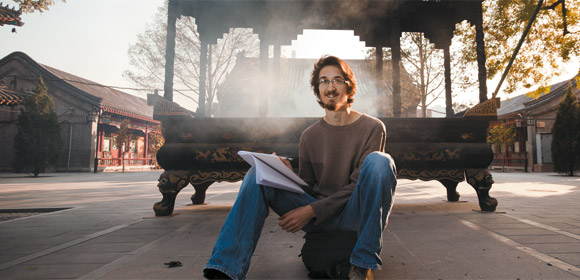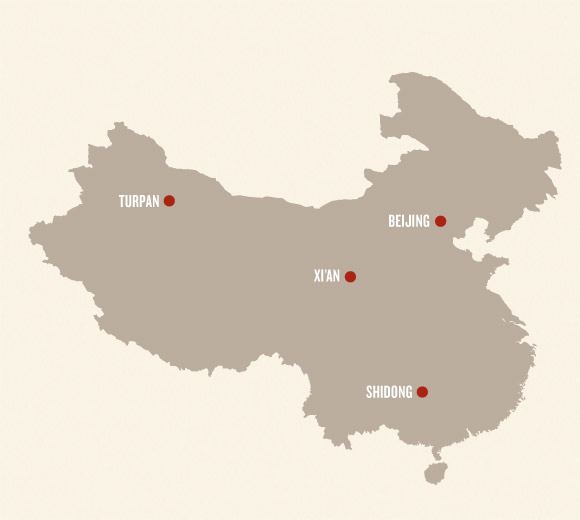
China from the Inside
Two students break their own paths into a complex country.
By Laura Demanski, AM'94 | Photos by James Wasserman
When the East Asian Civilizations program began this September, Alexander Kramarczuk, '12, and Karissa Woienski, '13, were part of the first group of College students to break in the University's new Center in Beijing, where their classes met. They arrived in China—he for the second time, she for the first—with ambitions to master the language and better grasp the country's constellation of cultures. By December, on the eve of their stateside return, Kramarczuk and Woienski were acutely aware of how tiny a dent they had made in getting to know Beijing, let alone China. But both will be back. And both had stories.
CHINA CONTAINS MULTITUDES, AND ITS RICHNESS FASCINATES ALEXANDER KRAMARCZUK—not just the myriad of cultures, climes, and peoples within the country, but the contradictions he observed within them since June, when he arrived in Beijing from his home state of Minnesota. This was Kramarczuk's second visit to the country. During a 2007 cultural exchange trip through his high school, China hooked him. "Before, I studied French and Portuguese," he says. "Though they're very vibrant, they don't have that zip that Chinese culture has."
Kramarczuk, a probable sociology major, spent his first eight weeks in Beijing taking the Princeton in Beijing language program, in which students must pledge to speak only Chinese for the duration. "You break the pledge, you go home," he says. "It's an honor system. I held to it—I liked it a lot. As soon as the program ended and I started speaking English, I could tell my Chinese was going downhill." With a month to fill before East Asian Civilizations started, he e-mailed China-related nonprofits looking for ways to see more of the country, as more than a tourist.
The Seattle-based China Tomorrow Education Foundation came through with an opportunity to teach English to third graders in Shidong, a tiny town in an autonomous region of the southwest called Guizhou. Shidong is home to Dong people, one of 56 recognized minority ethnic groups in China. Kramarczuk and a friend from the language program reached Shidong via a 27-hour train ride plus seven hours on two buses. The town has about 700 people, one street, and no showers. Rice and pig farming are the main occupations. Kramarczuk loved it, and the feeling was mutual.
 "The people in Shidong attach very quickly and they're very kind, very lively, very emotional," he says. "It's like a small American town in the concentration of the culture. You can really see a slice of life being acted out. Because they're a minority people, their culture is different from what I've experienced in Beijing." He was especially struck by how, in a poor town that lacks many basic services, people provided for their neighbors. "It's something you don't see in big cities, where people are on their own track."
"The people in Shidong attach very quickly and they're very kind, very lively, very emotional," he says. "It's like a small American town in the concentration of the culture. You can really see a slice of life being acted out. Because they're a minority people, their culture is different from what I've experienced in Beijing." He was especially struck by how, in a poor town that lacks many basic services, people provided for their neighbors. "It's something you don't see in big cities, where people are on their own track."
In Shidong's elementary school, Kramarczuk and his friend taught third and fourth graders who were just beginning English. "It was very basic: country names, animal names, food. We also did pronunciation classes with the teachers for about a week." Their stay was cut short after a couple of weeks because of a law, unknown to them and to town officials, that forbids distributing any printed materials not preapproved by the government. Their English vocabulary sheets fell afoul of the regulation, and the two Americans were asked to leave the county a week or so short of their planned departure. The police officers who spoke to them, Kramarczuk says, were "very nice, very friendly, willing to help," but "sticklers for the rules. If you violate any rule, however big or small, they will punish you."
Back in Beijing in mid-September, Kramarczuk missed the south. But his imagination was captured all over again by the west, in comparative literature professor Tamara Chin's lectures about the Han dynasty and the Silk Road trade route. He approached guest lecturer Guo Wu, a Chinese archaeologist, about the latter's current dig and received an invitation to visit. In mid-October Chan took the entire class on a three-day field trip to Xi'an, west of Beijing, to see up close the city that was China's ancient capital. After the field trip, Kramarczuk pressed on further west to Xinjiang to join Guo's team as they excavated a first-millennium Buddhist grotto near Turpan.
By the time Kramarczuk's stay in China was drawing to a close in late November, he had perhaps seen more of the country than any of his classmates. If he was less certain than ever about what China is, he was also more captivated by the conundrums he'd witnessed: the recent breakneck pace of change versus the country's "irreplaceable, glorious past" and the homogenization of the capital city versus the "special spark or spirit that hasn't been broken" that struck him in the west. "The idea of China," he says, "is beyond any one person's grasp. It's just too much. That's what I like, though. What good is life if you know everything?"
